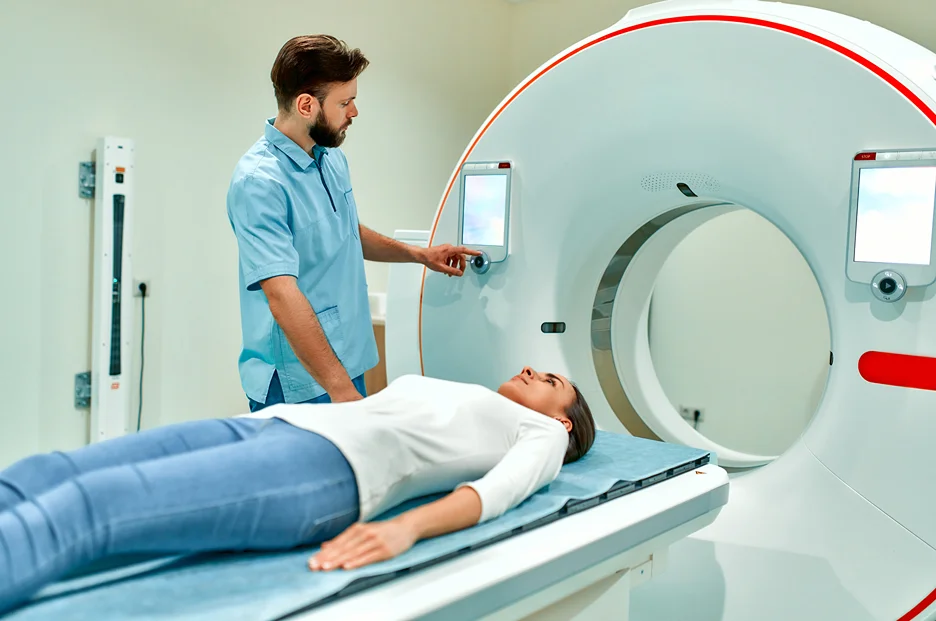If you experience severe pain radiating down your leg that seems to worsen around your period, you may be wondering what’s causing this agonizing symptom. For some women, this type of leg and back pain that flares up during menstruation could be a sign of a condition called sciatic endometriosis.
At Kaly, we understand how debilitating and disruptive chronic pain can be. That’s why we’re here to help you get to the bottom of what’s behind your symptoms, so you can start finding real relief. In this article, we’ll explore the ins and outs of sciatic endometriosis—from causes and risk factors to diagnosis and treatments—so you can take charge of your health.
What is Sciatic Endometriosis?
Sciatic endometriosis refers to endometrial tissue growing outside of the uterus and attaching to or compressing the sciatic nerve. This can cause severe sciatic nerve pain radiating down the legs.
According to a pilot study, leg pain is 51% prevalent to women experiencing endometriosis. When endometriosis lesions develop near the sciatic nerve, they can cause inflammation, irritation, and pain along the nerve pathway.
Endometriosis is a condition where tissue that normally lines the uterus grows in other areas, like the ovaries, fallopian tubes, and pelvis. This tissue still acts like the uterine lining, thickening and breaking down each month in response to hormones.
Since the sciatic nerve runs from your lower back down through your hips and buttocks. It branches down the back of each leg all the way to your feet.
What Are the Symptoms of Sciatic Endometriosis?
A major sign of sciatic endometriosis is that it often worsens around your period. The lesions can become inflamed and irritated during menstruation as the tissue builds up and breaks down.
- Burning, shooting, or stabbing leg pain
- Numbness or tingling down the leg
- Pain in the lower back, buttocks, hips, thighs
- Pain worsening with activity like standing or exercise
- Pain during sex, bowel movements, coughing, or sneezing
Why Does Sciatic Pain Get Worse Around My Period?
If you notice your sciatica symptoms flaring up just before or during your period, this cyclical pattern provides an important clue. Doctors call this phenomenon “catamenial sciatica” – when sciatic pain is linked to the menstrual cycle.
This happens because the endometrial lesions are directly affected by the hormonal changes related to your period. The tissue builds up and then breaks down and bleeds every month in response to estrogen and progesterone fluctuations.
This added inflammation and irritation during your period can place more pressure on the sciatic nerve, triggering or exacerbating sciatic pain symptoms. Tracking your symptoms and your menstrual cycles can help confirm if this monthly pattern is present.
How is Sciatic Endometriosis Diagnosed?

Getting a proper diagnosis for sciatic endometriosis can take patience, but there are a few main ways your doctor may go about it:
| Diagnostic Test | Description |
| Medical History & Physical Exam | Your doctor will ask about your symptoms, any family history of endometriosis, and examine you for signs of endometriosis. |
| Imaging Tests | An MRI is ideal for detecting endometriosis lesions on the sciatic nerve. A transvaginal ultrasound may also be used. |
| Laparoscopy | This minor surgery allows your doctor to look inside your pelvis with a camera for signs of endometriosis. Samples can also be taken. |
| Trial of Hormonal Treatment | Your doctor may try putting you on birth control pills or other hormones that reduce menstrual bleeding. If this relieves your sciatic pain, it suggests a link to your cycle. |
What Are the Treatment Options for Sciatic Endometriosis?
Treating sciatic endometriosis usually requires a combination of medication and surgery:
- Pain medication helps reduce inflammation and offer relief from sciatic pain. Over-the-counter options like NSAIDs can help, as well as prescription nerve pain medication.
- Hormonal medication like birth control pills and gonadotropin-releasing hormone (GnRH) analogs disrupt the menstrual cycle, which may relieve symptoms. According to studies, GnRH are 55-77% effective in reducing dysmenorrhea pain in patients.
- Nerve block injections can temporarily numb the sciatic nerve, providing short-term pain relief.
- Laparoscopic surgery is considered the gold standard treatment. It allows precise removal of endometrial lesions from the sciatic nerve and relief of compression, delaying surgery risk of permanent nerve damage.
Resolving the underlying cause of the inflammation through excision surgery and medication can greatly reduce or eliminate sciatic pain.
The Takeaway: You Don’t Have to Suffer Through Sciatic Pain

If you’re experiencing severe sciatic pain that seems tied to your menstrual cycle, don’t ignore it or chalk it up to normal period problems. The cause could be sciatic endometriosis – a treatable condition.
Getting an accurate diagnosis is the first step toward relief. Kaly can connect you with top specialists to get you answers and personalized care for sciatic endometriosis. With proper treatment, you can get back to living your life without this debilitating pain. The key is taking action and finding the right care team on your side.
Don’t let sciatic endometriosis hold you back another day. Visit Kaly today to get matched with a doctor who can help you find real solutions. There are many options for treating sciatic endometriosis – you just have to take the first step. We believe you deserve to feel your best all month long.
Frequently Asked Questions
What is catamenial sciatica?
Catamenial sciatica refers to pain associated with a woman’s menstrual cycle. It worsens before or during menstruation and improves after menstruation ends. It is typically caused by endometriosis outside of the pelvis involving the sciatic nerve or its related structures like the lumbosacral plexus.
How does sciatic endometriosis affect fertility?
Endometriosis is associated with reduced fertility due to lesions and scarring that can damage the fallopian tubes and ovaries. When endometriosis lesions grow on the sciatic nerve it can potentially damage the nerves, disrupting normal reproductive and menstrual cycle functioning.
The lesions and scarring from sciatic endometriosis can also indirectly impact fertility by decreasing the chances of successful embryo implantation in the uterus. Surgical removal of deep lesions involving the sciatic nerve may help improve fertility outcomes.
Can you get sciatic endometriosis after a hysterectomy?
It is possible to develop sciatic endometriosis after a hysterectomy, though it is rare. Endometriosis can recur or persist after a hysterectomy alone if the ovaries are not also removed, as endometrial tissue can still be stimulated by ovarian hormones even without the uterus.
While less common after menopause due to lower estrogen levels, endometriosis can in some cases continue after menopause.
How does the menstrual cycle influence sciatica?
Catamenial sciatica can wax and wane with the menstrual cycle. This is typically caused by pelvic endometriosis affecting the sciatic nerve. As estrogen and progesterone levels fluctuate during the menstrual cycle, it can trigger leg pain from sciatic endometriosis.
Symptoms often resemble regular sciatica but the concurrence of symptoms and the menstrual cycle can indicate sciatic endometriosis.
